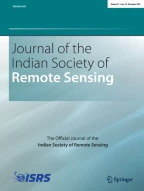Abstract
Remote Sensing and Geographic Information System (GIS) techniques are being effectively used in recent times as tools in determining the quantitative description of basin geometry i.e., morphometric analysis. In the present study, each of the nine subwatersheds of the major part of Nayagram Block in the Midnapore District, West Bengal have been studied in terms of the morphometric parameters - stream length, bifurcation ratio, drainage density stream frequency, texture ratio, form factor, circularity ratio and elongation ratio and prioritised all the subwatersheds under study.
The results suggest that the ratio between cumulative stream length and stream order is constant throughout the successive orders of a basin. The morphometric parametersbifurcation ratio and drainage density, confirm that the area is under dense vegetation cover and virtually the drainage has not been affected by structural disturbances. The form factor values indicate that the basin has moderately high and short duration peak flows. It was observed from the prioritisation of subwatersheds, the subwatershed 8 has got the highest priority because of high erosion intensity considering the above mentioned morphometric parameters. The subwatersheds have been analysed through Sediment Yield Index (SYI) model also and the results tally in most of the cases with the present approach. The subwatershed 8 is coming under priority—I by SYI model also, which indicates that the morphometric analysis could be used for prioritisation of subwatersheds even without the availability of reliable soil maps of the area under study.
Similar content being viewed by others
Reference
Chaudhary R S and Sharma P D (1998). Erosion hazard assessment and treatment prioritisation of Giri river catchment. North Western Himalayas. Indian J. Soil Conservation, 26(1): 6–1 1.
Mishra N, Satyanarayana T and Mukherjee R K (1984). Effect of topo element on the sediment production rate from subvvatersheds in upper Damodar valley. J Agric. Engg. ISAE. 21(3): 65–70.
Morisawa M E (1958). Measurement of drainange basin outline form, J. Geol, 66: 587–591.
Nautiyal M D (1994). Morphometric analysis of drainage basin using aerial photographs; a case study of Khairkuli basin. District Dehradun. W.P. J. Indian Soc. Remote Sensing, 22(4): 251–261.
RRSSC-Kharagpur (1996). Integrated Mission for Sustainable Development. Nayagram. Midnapore district. W.B. Technical report:1/IMSD(S)/ RCK:811. ISRO. DOS: pp. 7-49.
Strahler A N (1964). Quantitative geomorphology of drainage and channel networks. Handbook of Applied Hydrology. (Ed. By Ven Te Chow) Me Graw Hill Book Company. New York. pp 4–39-4-76.
Sebastian M, Jayaraman V and Chandrasekhar M G (1995). Space technology applications for sustainable development of watersheds. Technical report: 1SRO-HQ-TR-104-95. ISRO. Bangalore: pp 1–41.
Author information
Authors and Affiliations
About this article
Cite this article
Biswas, S., Sudhakar, S. & Desai, V.R. Prioritisation of subwatersheds based on morphometric analysis of drainage basin: a remote sensing and gis approach. J. Indian Soc Remote Sens 27, 155–166 (1999). https://doi.org/10.1007/BF02991569
Received:
Issue Date:
DOI: https://doi.org/10.1007/BF02991569


